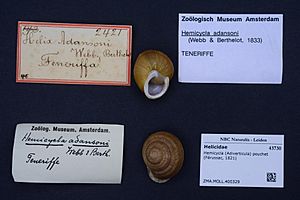Hemicycla pouchet facts for kids
Quick facts for kids Hemicycla pouchet |
|
|---|---|
 |
|
| Hemicycla pouchet shells | |
| Conservation status | |
| Scientific classification | |
| Synonyms | |
|
The Hemicycla pouchet is a special type of land snail. It belongs to the Helicidae family, which includes many common garden snails. This snail is quite unique because it is endemic to the Canary Islands. This means you can only find it living naturally in the Canary Islands and nowhere else in the world!
Contents
Discovering the Hemicycla Pouchet Snail
This interesting snail was first described in 1821 by a scientist named André Étienne d'Audebert de Férussac. Scientists give each species a special two-part name, like Hemicycla pouchet, so everyone knows exactly which creature they are talking about.
Where Does This Snail Live?
The Hemicycla pouchet snail makes its home in the beautiful Canary Islands. These islands are located off the northwest coast of Africa. They have a warm climate and diverse landscapes, which are perfect for many unique plants and animals, including this snail. Snails usually prefer damp, shady places to live. They might be found under rocks, logs, or among plants.
What Do Snails Like to Eat?
Most land snails, including those in the Helicidae family, are herbivores. This means they eat plants. They use a special ribbon-like tongue called a radula to scrape off tiny bits of food. Snails often munch on decaying leaves, fungi, algae, and soft plant parts. They play an important role in their ecosystem by helping to break down plant matter.
The Life Cycle of a Snail
Snails are fascinating creatures with an interesting life cycle. Most land snails are hermaphrodites, meaning they have both male and female reproductive organs. However, they usually still need another snail to mate with. After mating, both snails can lay eggs.
Snail Eggs and Young Snails
Snail eggs are often laid in moist soil or under leaf litter to keep them safe and hydrated. The eggs hatch into tiny snails that look like miniature versions of their parents. These young snails grow by adding new layers to their shells. Their shells grow with them, providing protection as they get bigger.
Why Is This Snail Vulnerable?
The Hemicycla pouchet snail is currently listed as "Vulnerable" (VU) by the IUCN. This means it faces a high risk of becoming extinct in the wild.
Threats to Snail Populations
Being endemic to a small area like the Canary Islands makes this snail more vulnerable. Threats can include habitat loss due to human development, changes in climate, or the introduction of new species that might compete with them for food or prey on them. Protecting their natural habitat is very important to help these unique snails survive.
See also

- Land snail
- Canary Islands
- In Spanish: Hemicycla pouchet para niños


